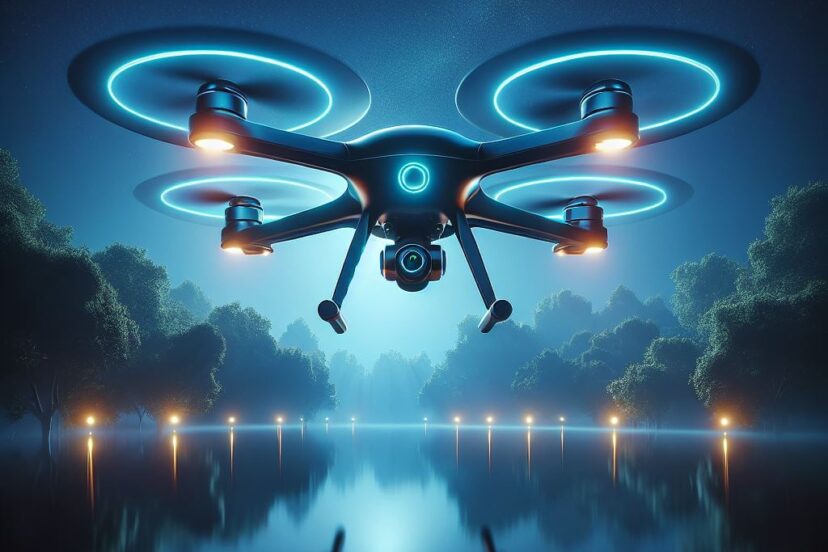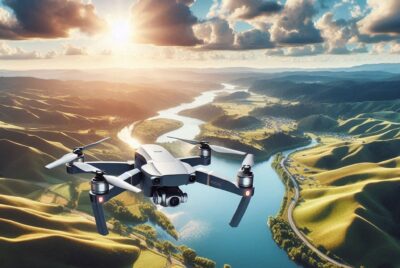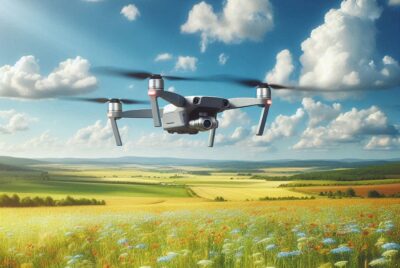Drone Night Lights: Enhancing Visibility for After-Dark Flights
*We may earn a commission for purchases made using our links. Please see our disclosure to learn more.
Drone Night Lights: Enhancing Visibility for After-Dark Flights
I’ve noticed that the use of drone night lights has become increasingly important for night flights. Complying with regulatory standards, like those set by the Federal Aviation Administration (FAA), ensures that pilots can safely operate their drones after dark. Anti-collision lights, often referred to as drone strobes, play a crucial role in maintaining visibility and safety during these operations.
When flying at night, the importance of being seen in the sky cannot be overstated. Drone strobe lights offer a solution to this by providing bright, visible lighting that alerts others to the drone’s presence. The market offers a variety of drone lights that feature different brightness levels, battery lives, and ease of use, catering to both recreational flyers and commercial operators.
My experience reaffirms that selecting the right lighting is pivotal for nocturnal drone activities. The lights not only ensure compliance with laws but also enhance the capacities of drones in low-light conditions, such as search and rescue operations, photography, and videography. Compact and lightweight, these lights are designed to attach to various drone models without impacting their performance, allowing for safer and more effective night-time flights.
Drone Night Lights Fundamentals

In this section, I’ll go in-depth about the practical and regulatory aspects of drone night lights, focusing on their types and uses, as well as the specific FAA guidelines governing their operation after dark.
Understanding Drone Lights
My operation of drones at night necessitates the use of drone lights for visibility and safety. Two main types of lights are commonly used: navigation lights and anti-collision lights. Navigation lights help me determine the orientation of my drone during flight, while anti-collision lights are crucial for maintaining visibility to other aircraft. The lights should ideally be LED lights due to their high luminosity and low energy consumption.
Most of my drones require strobe-capable lights which are powerful enough to ensure visibility from a distance. I prefer using high-intensity LED lights like the Lume Cube Strobe because they are visible for at least three miles, meeting a crucial visibility requirement.
I often choose lights based on the specific requirements of my drone’s use case. For instance, if my primary use is for photography at night, I would opt for a drone lighting system that not only illuminates the drone itself but also provides sufficient lighting for my camera’s ISO settings to capture clear, high-resolution images.
FAA Regulations on Night Flights
As a certified Part 107 drone pilot, I must adhere to the FAA regulations that dictate the operations of drones at night. The FAA requires drones to have anti-collision lights that are visible for at least three miles and have a flash rate sufficient to avoid collisions, as per the three-mile visibility requirement.
The FAA specifies that drones flying during civil twilight (which is 30 minutes before sunrise and 30 minutes after sunset), and at night must be equipped with appropriate anti-collision lighting. The following is a general summary of the FAA’s night flight regulations:
- Anti-Collision Lights: Must be visible for a minimum of 3 miles.
- Flight Time: Operations are allowed during civil twilight and after dark.
- Pilot Requirement: Pilots must complete an updated knowledge test or training, such as recent updates to the Part 107 regulations.
The FAA does not specifically endorse any brands, but lights like Lume Cube or FireHouse strobes are popular among drone pilots because they meet or exceed these requirements. My compliance with these regulations ensures safety and legality when I fly my drone at night.
Operational Guidance for Night Flight

When I conduct night flights with my drone, I ensure compliance with FAA regulations and prioritize safety through meticulous pre-flight planning, in-flight procedures, and post-flight checks.
Pre-Flight Checklist
Visibility: Before launching, I check if the visibility is at least 3 statute miles. This is critical for maintaining visual line of sight with my drone, especially after dark.
Navigational Lights: I confirm that my drone is equipped with navigational lights. The red and green lights must be visible for a minimum of 3 statute miles. Additionally, I make sure they are functioning correctly and the colors are correctly placed, red on the left and green on the right, to indicate direction.
Strobe Lights & Lumens: To enhance visibility, I attach a strobe light such as the LumeCube Strobe. This powerful light surpasses the 3-mile visibility requirement with its intensity measured in hundreds of lumens.
Battery Life: I verify both my drone’s and strobe light’s batteries are fully charged. This ensures the lights will last for the entirety of the flight. Mounting options like Velcro can be used for attaching strobe lights, but I make sure they are secure and don’t interfere with the drone’s operation.
During Flight
Maintaining Visibility: Once airborne, I continuously monitor visibility and keep my drone within visual line of sight. This is essential for avoiding collisions and for situational awareness.
Navigational Lights Inspection: I regularly check the red and green navigation lights for proper function. This directly aids in determining my drone’s orientation and direction.
Post-Flight Procedures
Inspection: After landing, I inspect my navigational and strobe lights for any damage or malfunctions that could affect future flights.
Battery Maintenance: I also check the battery levels to record and manage the battery life for my next flight planning. This is crucial for ensuring operational readiness of the lights.
Throughout the process, I remain alert to my surroundings and maintain situational awareness, which is a key component of safely conducting night operations with a drone.
Advanced Lighting Techniques for Nighttime Operations

Nighttime drone operations require specialized lighting techniques to ensure safety and to enhance the quality of photographs and videos. As a drone operator, I use a variety of advanced lights that serve both functional and creative purposes.
Optimizing Visibility and Safety
For safety and compliance with Federal Aviation Administration (FAA) regulations, my drone is equipped with an anti-collision strobe light during twilight and night flights. I use the FoxFury D3060 which provides 360-degree visibility due to its dual-adaptable lights with three different lighting modes: fast strobe, slow strobe, and continuous. The runtime of the lights is crucial; the D3060 lasts up to three hours, ensuring my drone remains visible for the duration of its flight.
In search and rescue operations, drones are invaluable assets. I often attach a spotlight like the LitraTorch 2.0 which casts a wide, bright beam that can illuminate large areas, helping in low-light conditions. This light not only provides visibility for my camera but also aids ground teams by highlighting important areas and objects.
Creative Use of Light in Night Aerial Photography
When engaging in night aerial photography and videography, creativity is key. I experiment with different lighting to achieve the desired artistic effect. The Ulanzi DR-01 drone light is my choice for this purpose; it offers adjustable brightness levels which is indispensable for handling the nuanced lighting requirements of twilight and night scenes.
By strategically using these lights, I elevate the quality of my photos and videos, from capturing the gentle glow of twilight to the stark contrasts of urban nightscapes. By combining the Ulanzi DR-01’s adjustable brightness with the camera settings, I shoot in high detail even in challenging light.
Lighting techniques in nighttime drone operations are not just about compliance and visibility but also about enhancing the art of aerial imagery and aiding in critical missions like search and rescue.
Drone Equipment and Accessories

In my experience with drone operation, night flights require specialized equipment to enhance visibility and safety. Proper lighting is not just a convenience, but a necessity for compliance with regulations and enhancing the drone’s capabilities.
Selecting the Right Lights for Your Drone
When choosing lighting for your UAV, the primary aspects to consider are visibility and compliance with the FAA’s Part 107 rules. For high visibility, the Firehouse ARC V strobe is an excellent option, offering a 1000 Lumen Output, making it one of the brightest lights in the market. It ensures a 4 SM range of visibility, a feature particularly useful for police and security drone operations. For drone models like the DJI Mavic or DJI Matrice which are commonly used by professionals, lights must not interfere with the UAV’s obstacle avoidance systems. The TOPSUN CREE LED light is a notable mention, known for its bright and directional light which is critical for my night operations without hindering onboard sensors.
Key Features to consider:
- Brightness & Visibility: Ideally above 500 lumens for clear visibility.
- Battery life: Longer battery life for extended use.
- Weight: Should be lightweight to minimize impact on drone performance.
Attachment and Mounting Solutions
The method of attaching lights to your drone is almost as important as the light itself. A secure attachment ensures that the light remains in place during flight and does not affect the drone’s stability. Many drones, such as the DJI Mavic, have specific attachment points or accessories designed for additional equipment. Always ensure the light’s mounting mechanism is compatible with these points. Mounting solutions should provide a firm grip without damaging the drone’s exterior. In addition, consider the ease of mounting and demounting, as I frequently need to attach lights on the fly, and complex systems can impede rapid deployment, which can be crucial for UAV pilots.
Mounting Checklist:
- Compatibility: Check with your drone’s model.
- Non-Damage: Materials should not scratch or damage the drone.
- Stability: Ensure that lights remain steady during all phases of flight.
- Tool-Free: Preferably, mounting solutions should require no tools for attachment.
Legal and Ethical Considerations

When operating drones during nocturnal hours, compliance with FAA regulations and the prioritization of public privacy and safety are paramount. These concerns guide the responsible use of drones in sectors like agriculture and inspection, as well as in the broader drone industry.
Compliance with Local Regulations
I must familiarize myself with local regulations concerning drone night flights. The FAA mandates that all commercial drone pilots, including myself, adhere to specific rules under CFR Part 107 for night operations, effective since April 21, 2021. For example, drones are required to have anti-collision lighting, such as the Firehouse Arc “V”, that is visible for a minimum of 3 statute miles. Additionally, as a pilot, I should:
- Ensure that the drone is equipped with proper lighting to maintain visibility.
- Operate the drone within the visual line-of-sight, either directly or with the help of a visual observer.
- Remain updated on FAA requirements to avoid any legal complications that can arise from non-compliance.
Ensuring Public Privacy and Safety
While flying drones at night, I am responsible for addressing privacy concerns and maintaining safety standards. My actions should not infringe upon the privacy rights of individuals. Safety measures I take include:
- Conducting pre-flight checks to ensure that the drone and all its systems, such as navigation lights, are in optimal condition.
- Avoiding flying over populated areas to prevent any invasion of public privacy.
- Retaining a safe distance from people and private properties to minimize risks and potential disturbances.
By adhering to these legal and ethical considerations, I contribute to the safe and respectful growth of the drone industry, while observing the obligations set forth for commercial and recreational drone use.
FAQs About Drone Night Lights
Drones have specific lighting requirements for night flights to ensure visibility and safety. The lights play a critical role in locating and determining the orientation of the drone in the sky.
1. What type of lighting is required for drones during nighttime operations?
For nighttime operations, drones need to be equipped with visible lighting. This includes red and green position lights that indicate the direction of the drone. Strobe lights or anti-collision lights are also recommended to enhance visibility from a distance.
2. How do different anti-collision lights on drones enhance safety at night?
Anti-collision lights on drones, such as strobe lights, make drones more detectable to other aircraft and people on the ground. These lights are usually bright and can blink or flash, signaling the drone’s location to prevent potential accidents.
3. What features should one look for when purchasing drone lights for nocturnal usage?
When purchasing drone lights for nighttime use, I look for lights with high luminescence and the capability to flash, as these are more noticeable at night. The battery life and ease of attachment are also important to ensure the lights last for the duration of the flight and can be securely fastened to the drone.
4. What are the regulatory requirements for operating drones with lights at night?
Regulatory requirements for drones with lights at night typically include having a lighting system that allows for the determination of the drone’s orientation and location. It’s essential to consult local regulations, as they can vary, but visibility from a three-mile radius is a common stipulation.
5. In what ways can night vision cameras on drones benefit nighttime flights?
Night vision cameras on drones benefit nighttime flights by enhancing the operator’s ability to see in low-light conditions. These cameras can pick up heat signatures and provide a clearer view of the ground, aiding in navigation, search and rescue operations, and surveillance.




